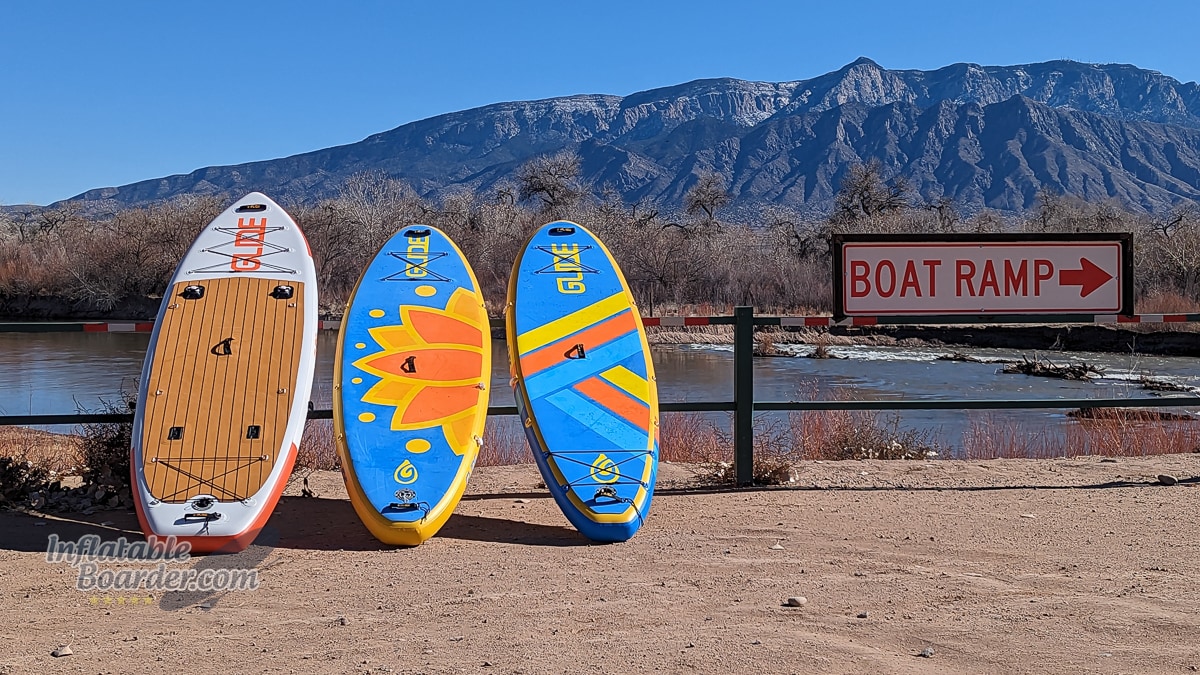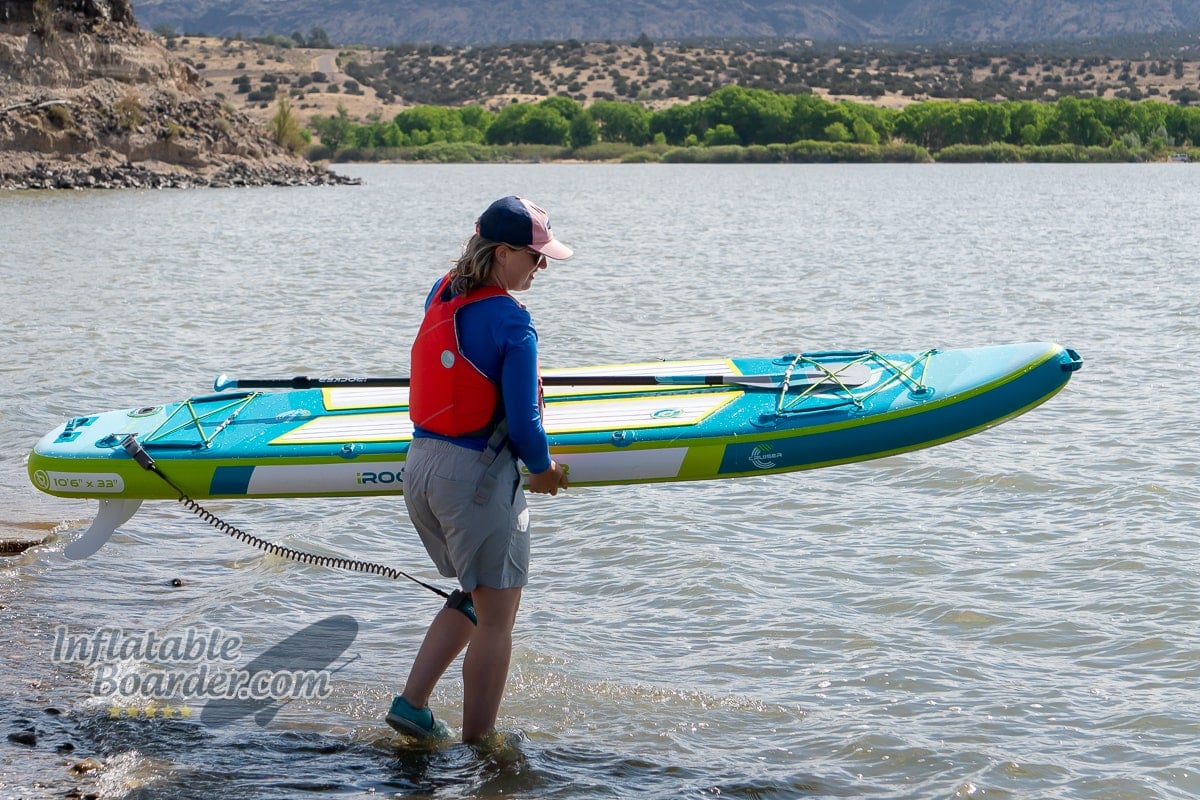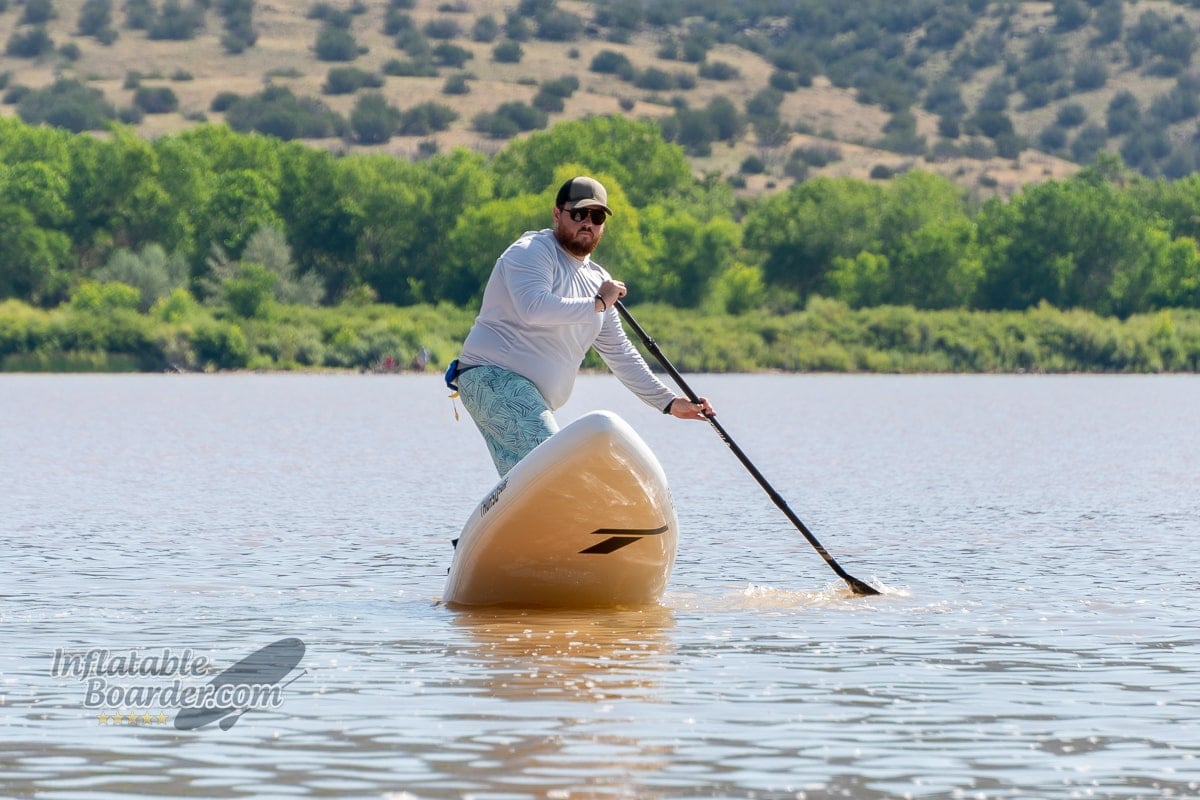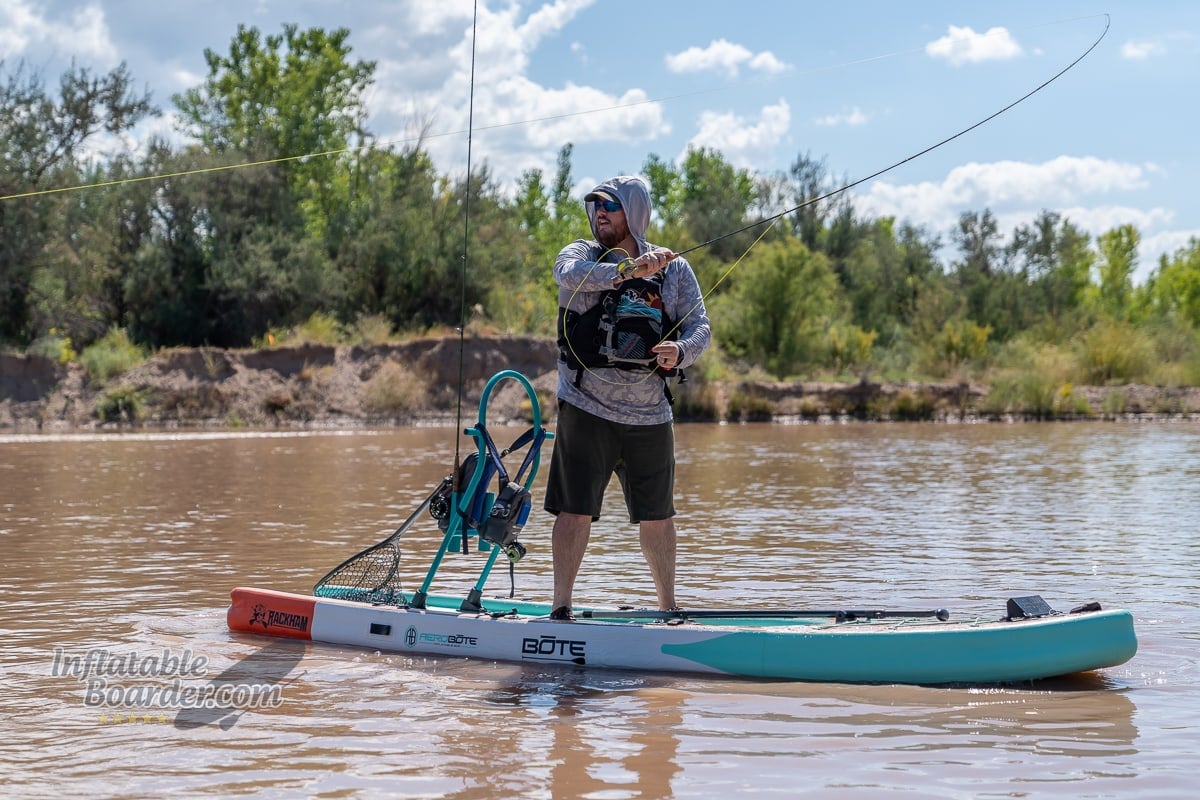
There are about a million things to consider when buying a paddleboard (well, it can feel like that at least) and chief among them is size. What size SUP do I need? How do I even know where to begin? What if it’s too small or too large? What if I want to bring my dog with me? Can I paddle with a friend on my iSUP? All of these questions and more are going to depend on a few different factors.
Unfortunately, there’s no silver bullet answer for “what size iSUP should I get?” But the good news is we aren’t dealing with werewolves anyway, so there’s plenty of ways to figure out what size paddleboards you should consider. In this guide, we’re going to go through the basic information you’ll need to know in order to find the right size iSUP for you.
We’ll start with some general sizing and then get more specific as we go through the guide. For the most part we’ll be assuming you are in your first season of paddleboarding and looking to purchase an all-around style paddleboard rather than a highly-specialized design. But we’ll also include sizing tips for those specialized boards as well.
There is a set of general size guidelines for different types of paddleboards at the end of this guide – but I urge you to read the full guide to really get a feel for how to pick the right size board for you.
Best Size iSUP for Beginners
If you are new to paddleboarding – welcome! To get you started on the right foot, it is really important to get the right size for you. To that end, unfortunately, there’s not a perfect “beginner’s” size paddleboard. However, the good news is that using your weight and height in the next section will put you in a really good spot to start when searching for an all-around style iSUP. If you think you’ll want something with a little more stability to make it easier to get started, add an extra inch or two onto the suggested width. If you tend to take to new sports quickly and like to push yourself, I still recommend sticking with these size guidelines to start with, or consider moving directly to a touring-style iSUP that is just a little narrower, but longer.
Let’s Talk About You
If you’re buying a paddleboard for yourself, it’s important to make sure it fits you and your uses! If you are the best friend/partner/family member in the world and you’re buying an iSUP for someone else, just make sure to consider that person as you read through this guide.

Two of the most core pieces of information you’ll need are your height and weight. These two features will give you a starting point that we’ll be able to build from. Of these two features, weight is typically the most important. iSUPs have the benefit of a relatively high volume compared to most rigid SUPs. Instead of focusing on volume like we would when rigid board shopping, we’re going to look more at the overall dimensions. Lastly, your skill level will also play a role in selecting the right size.
Length
There is a significant amount of forward/backward body movement while paddling. While shorter paddlers can use longer boards if desired, taller paddlers are usually more comfortable on longer paddleboards.
- Paddlers who are under 5’2” tall can use smaller iSUPs 9’6” – 10’6” long
- Paddlers who are 5’3”-5’11” should look for iSUPs 10’6”-11’6”
- Paddlers who are over 6’0” tall should use iSUPs at least 11’ long
Width
A paddleboard’s width (along with several other things) is key to how it behaves on the water – especially how stable it is and its overall capacity. Length, thickness, and shape also play into stability and capacity, but width is a good starting point. Wider boards will typically be more stable than narrower boards.
For total weights (Paddler + cargo or passengers)
- <140 lbs - iSUPs 28-32” usually offer enough stability
- 141-220 lbs – iSUPs 31-33” are great for all-around paddling
- >220 lbs – iSUPs 33-36” offer more stability and capacity while maintaining normal performance
- Paddlers with a total weight over 220 lbs should also consider using a board that is 11’ or longer
- Paddlers under 5’2” should consider narrower boards closer to 30” wide to make reaching over the side of the board to paddle easier.

Skill and Comfort Level
As you get more time on the water and more comfortable paddleboarding, you can use boards that might be technically “too small.” So far, according to this guide, I should be looking for a board around 11’ long and 33”-34” wide. However, with my skill and comfort level, I’m able to use boards as small as 10’ x 30”! While I certainly can use these small iSUPs, I still prefer the more typical 10-11’ x 32” sizes.
- Beginners who haven’t SUP’d or have only SUP’d a few times should generally stick with the general guidelines presented here, or even consider sizing up an inch in width
- Intermediate paddlers who are comfortable standing and paddling in mild to moderate conditions can usually step down in width by an inch or two if desired
- Advanced paddlers – If you’re comfortable walking around on your board and standing/paddling in difficult conditions, you probably aren’t reading this guide 😉 but you’re likely able to size down to much narrower boards if desired.
“Recommended Weights” and “Weight Capacities”
When shopping for a paddleboard or reading reviews you’ll usually come across some type of weight capacity specification. Most brands list a recommended weight range or maximum weight range for their products. These specifications can be confusing and difficult to compare as not all brands use the same type of metric. There are three basic forms of weight range or capacity that brands use:
Recommended Rider Weights
The listed recommended rider weights are general weight ranges for paddlers using that SUP in typical conditions (calm to mild) with typical lightweight daily-need equipment (water, sunscreen, small dry bag, etc.). Usually, brands will indicate rider weight specifically, however, iSUP capacities that are under 250lb are usually rider weights.
Maximum Capacity (for Normal Performance) – this is the most common form of weight capacity specification. This indicates the maximum total weight recommended in order to maintain the intended level of performance. These capacities are usually in the 250-400 lbs range
Maximum Capacity (Absolute Maximum) – this is a metric that some brands use in order to make their product look better to a potential customer. This indicates the maximum total weight that a paddleboard can hold before it sinks or becomes completely un-paddleable. Unless you are looking at multi-person paddleboards, weight capacities over 450 lbs usually indicate an Absolute Maximum weight capacity.
At inflatableboarder.com, we list weight capacities in our reviews the same as how the brands list them. Most of those fall into category 2 – Maximum Capacity for Normal Performance, and some fall into category 1 – Recommended Rider Weight.
Weight capacities can be initially helpful, but generally fall in line with sizing.
Larger iSUPs will have higher capacities. The rigidity of the paddleboard is sometimes factored into the weight capacity as well. iSUPs that are more rigid can more easily accommodate more weight before performance is impacted.
Sizing for Kids
Kids grow fast, but they aren’t always ready for a full-size paddleboard. Adult-size iSUPs are often too wide and too long to be easily paddled by shorter, lighter paddlers. There are several kids-specific iSUPs available, and, just like adult boards, they come in different sizes.
When sizing a paddleboard for your kids consider shorter (8-9’), narrower (28-30”) and thinner (4-5”) boards. These smaller, low weight boards still have plenty of volume and rigidity for your young paddlers, but will be physically easier for them to paddle on their own.
If your kids are in their tweens, you may want to consider a smaller-size adult board rather than a kids-specific board, depending on their height. I recently purchased a Nautical 10’6” iSUP (rather than a kids-specific board) for my 13 year old niece knowing that it might be just a tiny bit big now, but she’ll likely be plenty tall enough for it next year.
How Will You Use Your SUP?

So far we’ve been working under the assumption of sizing an all-around iSUP. All-around paddleboards, like their name implies, work well for a variety of different uses, but don’t necessarily specialize in any particular use. For some uses a different width or length may be desired. Your environmental conditions can also impact your sizing decision.
- If you want more stability for casual cruising, yoga, or paddling with a small passenger – consider adding 1-2 inches in width (33-34”).
- If you want more speed for fitness paddling or touring – consider a longer (12-14’) and narrower (28-30”) board.
- If you plan to surf – consider a shorter board (9’6”-10’) that is also thinner (4-5” rather than the typical 6”).
- If you are bringing lots of cargo and/or fishing – consider adding both width (34-36”) and length (11’-11’6”) for extra stability and more cargo room.
- If you plan to paddle whitewater – consider reducing your board length (9-10’) for maneuverability and adding width (34-36”) for stability.
I’ll never turn down a chance to paddle a beautifully calm, glassy lake or catch an early morning session in the bay. But sometimes I’ll get an itch for some of that Type 2 fun – where maybe things aren’t as ideal and it might be a little uncomfortable at times, but at the end of the day I’m glad I went out anyway. On those days when conditions are rougher, winds are higher, and the chop is deeper, I’m going to grab a different paddleboard than what I’d use on the glassy water. If you regularly paddle in rougher conditions (first, Bravo!) there are a few considerations to make when selecting a paddleboard.
- A wider iSUP is going to provide more stability than a narrower one, and
- A thinner iSUP (4-5”) is going to have less area along the sides to be pushed by the wind
- For paddling in fast-moving rivers, you’ll want a shorter board for better maneuverability, and potentially wider for better stability.
General SUP Sizing Guidelines
I wanted to put this information at the end of this guide rather than the beginning for two very important reasons:
1) These are very general recommendations, not a hard set of rules, and
2) These guidelines are intended to be used as starting points and then adjusted to suit your needs as discussed above
All-Around iSUPs
- Most paddlers will enjoy an all-around iSUP that is around 10’6” x 32” x 6” for general purpose paddling
- Smaller paddlers and Intermediate+ skill paddlers may prefer a thinner, 10’6” x 32” x 4.7” iSUP for general purpose paddling
- Check out our favorite All-Around iSUPs
Higher CapacityAll-Around iSUPs
- Larger paddlers and paddlers with lots of cargo (or a small passenger) will typically enjoy an all-around iSUP that is 11’6” x 34” x 6”
- Rigidity is also an important factor when selecting a higher-capacity iSUP
- Check out our favorite All-Around iSUPs for Heavier Paddlers
Touring and Fitness iSUPs
- When efficiency is key, many paddlers will reach for a 12’6” x 30” x 6” iSUP to balance speed and stability
- When speed is key, paddlers will find a 14’ x 26-28” x 6” iSUP to meet their needs depending on how much stability you want
- Check out our favorite Touring iSUPs
Fishing iSUPs
- When fishing from an iSUP you want to have plenty of capacity and stability to carry your gear and cast/land fish without going for a swim
- Most SUP anglers favor wide, boxy iSUPs 11’6” x 34-36” x 6-8”
- Check out our favorite Fishing iSUPs
Yoga iSUPs
- SUP yogis can greatly benefit from wider, boxier shapes around 11’ x 33-34” x 6”
- A full-length deck pad is one of the top features to look for in an iSUP for yoga
- Check out our favorite iSUPs for Yoga
River iSUPs
- For fast-flowing and turbulent rivers, a dedicated river or whitewater iSUP is ideal for good maneuverability and stability
- Most river paddlers choose iSUPs around 9’6” x 36” x 6” that have prominent nose rocker (and preferably tail rocker)
- Check out our favorite River iSUPs
iSUPs for Kids
- Kids can often struggle to paddle an adult size board, even relatively small ones.
- Most Kid’s iSUPs are 8’-9’ x 28-30” x 4-5” , younger kids will benefit from the smaller sizes, and older kids (up to around 12 years old) will benefit from the larger sizes.
- Check out our favorite iSUPs for Kids
Final Thoughts on Choosing the Right Size iSUP
Choosing the right size paddleboard is all about you – your size, your use, your conditions. There are definitely general guidelines on sizing that are a great place to start, but don’t be afraid to deviate from those guidelines. If you aren’t sure if a board is right for you or your use, ask around! Besides asking friends (or strangers) that have that particular board, don’t be afraid to message the brand themselves – most are happy to answer any questions you have. Of course you’re also welcome to ask us any questions you may have by using the Contact Us form at the bottom of this page.
Once you’ve chosen the right size paddleboard, can I interest you in some assistance choosing the right paddle to go with it? We’ve got an in-depth guide on Choosing SUP Paddles and a guide to our Favorite SUP Paddles with detailed reviews from the water.

